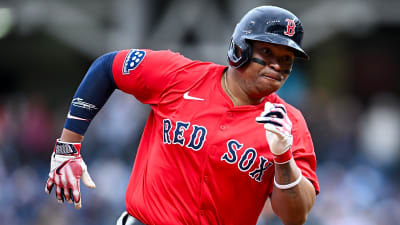
The ball jumped off the bat at 108 miles per hour, traveling on a laser-like line straight over the left field wall for a solo homer. The drive by rookie Tim Tawa extended the Arizona Diamondbacks' lead over the Tampa Bay Rays to 3-1 in a game they would eventually go on to win 5-1 in Tuesday night's series opener.
For fans in the stands unfamiliar with Tawa, it might have come as a jolt or a shock to see the unheralded rookie hit a ball with such ferocity. While it was his third homer of the year, coming in just his eleventh game of the year, it was his first in front of a home crowd.
Taken in the eleventh round of the 2020 amateur draft out of Stanford, Tawa has been somewhat of a late bloomer. He hit 13 homers in 2022, but batted just .239 for the year,, as his first taste of Double-A proved to be a challenge. He improved in 2023, batting .256 while clubbing 21 homers and posting a .799 OPS.
But it was 2024 when Tawa finally broke out, mashing 21 homers for Amarillo, and eleven more for Triple-A Reno for a total of 31, while batting .279 and posting an .868 OPS. He picked up right where he left off, and then some, at the start of 2025.
Tawa was batting .391 with three homers through his first six games for Reno when Ketel Marte went down with a hamstring injury on April 4. Tawa was called up to make his major league debut the very next day, hitting a single on a line drive to left field in his first major league at-bat.
Since then Tawa has steadily emerged at the plate, showing both good plate discipline and approach, along with the ability to hit the ball hard. He's currently batting .242/.366/.576, .942 OPS (league average OPS is only .702). He has two doubles, three homers, along with six walks. He's struck out just eight times in 41 plate appearances.
Prior to Tuesday's game Tawa's batting average was just .185, and his OPS was .747. But one could feel it coming watching his at-bats and batted balls. He hit a very long homer in Chicago against the Cubs, and had several sharp lineouts right at defenders in both the outfield and the infield.
In fact, underlying batted-ball-derived metrics such as expected batting average and slugging suggested that Tawa was performing much better than the results he had gotten to that point. Whether one was watching the games, or checking the underlying expected metrics, it seemed obvious Tawa was going to see improved results if he kept doing what he was doing.
Speaking prior to the game on Tuesday, manager Torey Lovullo was asked if the team considered the expected stats in their player evaluations.
"We look at some of the expected numbers all the time. It helps us get a gauge as to what should be happening. We know there's a good player in there," Lovullo said.
It can be difficult sometimes to know where to draw the line on evaluating a player before there is enough of a track record. Results such as batting average and other percentage metrics can be heavily skewed in a small sample size of results. The underlying batted ball and expected metrics can often help indicate future performance better than the actual results.
It's a balancing act for evaluators, without any exact science, whether going by traditional or advanced methods of player projection, and Lovullo admitted there can be spirited debates over this dynamic.
"I wish you'd be in my office when we're arguing about that exact topic. It just depends on what side of the ledger you're on and who you believe in and who you want more," Lovullo said.
"I love the actual numbers, but I have to be aware of the expected. I just don't want us to lean in one spot too heavily. I want us to pay attention to both and continue developing players. But it's a very fair question. And is it the chicken or the egg? You don't know."
For Tawa, he likes to simplify things and avoid looking at his results statistics. "The only thing I really like to look at is did I swing at a strike, did I control the zone well, and did I hit it hard," Tawa said.
"I don't really like to look at the [results] numbers. Sometimes it's impossible to avoid it when it's on the board in the stadium, but I just try to focus on having quality at-bats each time. I try to do whatever that situation requires, whether it's a team at bat, moving a runner over, or driving the ball somewhere," he continued.
It isn't just the hitting that's being focused on or evaluated of course. Lovullo is well known to be a stickler for defense, and "picking up the baseball" as he often says. Tawa had a couple of early miscues on defense, committing two errors and failing to turn a double play on another ball in which he was not charged an error.
Some of those miscues stood out as costly due to the timing they occurred in the game. But Lovullo was impressed by how Tawa responded.
"He continues to learn and play just as fast the next inning or the next game he's in there. That's hard to do, because you can start to get very tentative when you're a young player. But he's teeing it up there and letting it fly on the defensive side of it," Lovullo said.
"Making mistakes is part of the game," said Tawa. "You're not always going to be perfect even though you strive to be. I think more about how you respond to those and how you bounce back is really important. I don't want to lose my aggressiveness or my belief in myself. So I really try to take each individual rep or pitch as it's own play. Whatever happened in the past, I'll block that out and go make the next play"
A few examples of Tawa doing just that can be found in the video clip below.
It should be noted that playing fast and athletic is not something new to Tawa. The three-time Gatorade Football Player of the year in Oregon had an incredible high school career on the gridiron.
He threw for nearly 12,000 yards, and during his senior year amassed an astounding 55 touchdowns while throwing just one interception. He won a state championship, and of course was a standout for the Cardinal in baseball as well, playing in the College World Series.
Tawa has played all around the diamond in his professional career. The term "super utility player" has often been used to describe him. While he played more second base than any position in the minors, he played all three outfield positions, and occasionally some first and third base, and even a couple games at shortstop.
For now, second base is the position he'll play, at least until Marte returns. Marte appears to still be a week away from returning from the Injured List due to his hamstring strain. When he does come back, the Diamondbacks will have a very tough decision to make regarding Tawa.
While Tawa has played a couple of games at shortstop, that's not a position they consider him a depth option at. He certainly has the athleticism to handle shortstop, but just hasn't had the reps.
Light-hitting utility man Garrett Hampson has been getting crowded out of playing time since Tawa has emerged, but between him and top prospect Jordan Lawlar, Tawa may find himself in a roster crunch. For now however, all he can do is continue to play fast and athletic, and pound the baseball when he sees a strike. Diamondbacks fans can expect to see a lot more of both in the coming days.
TAWA HIT THE BUDS!!
— Arizona Diamondbacks (@Dbacks) April 23, 2025
Reply to this post with #hitthebuds and #sweepstakes for a chance to win a season’s worth of beer and an autographed D-backs jersey.@budweiserusa x #Dbacks pic.twitter.com/CcmqTZRPg9
More must-reads:
- Rafael Devers saga in Boston could take another interesting turn
- Notable update emerges about Dodgers' Shohei Ohtani
- The 'Active home run leaders in Major League Baseball' quiz
Breaking News
Trending News
Customize Your Newsletter
 +
+
Get the latest news and rumors, customized to your favorite sports and teams. Emailed daily. Always free!








